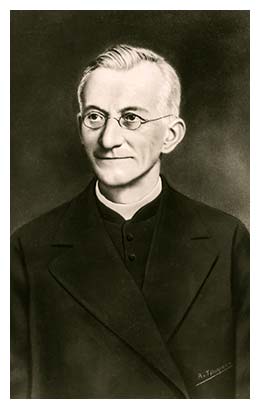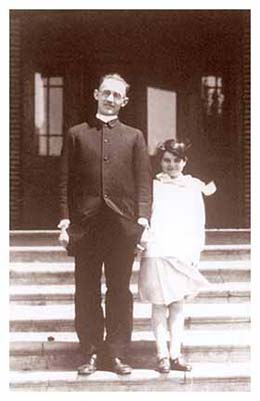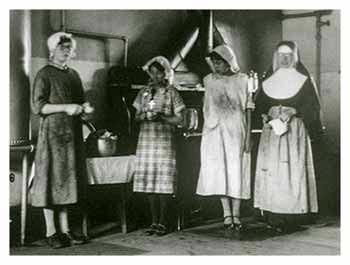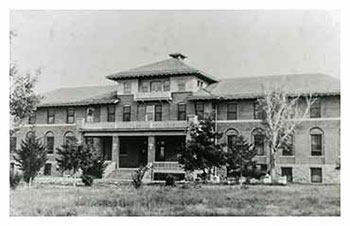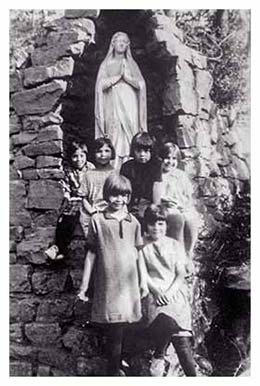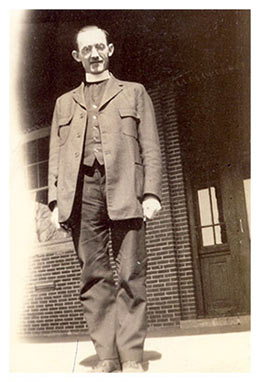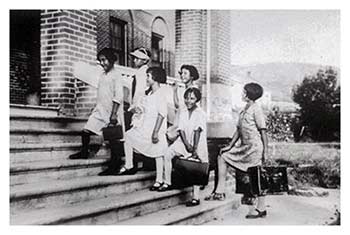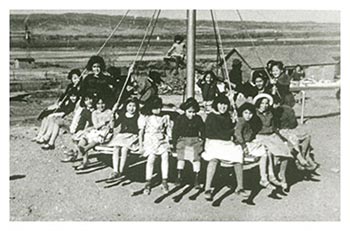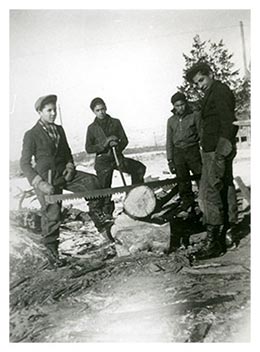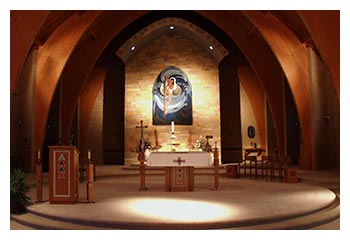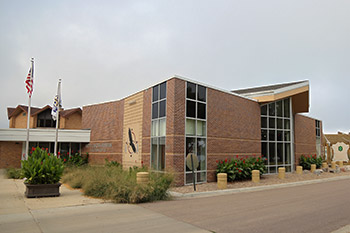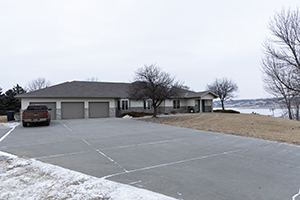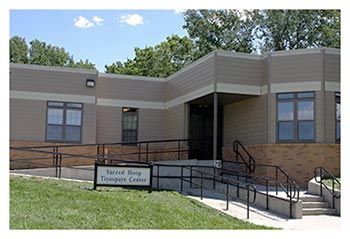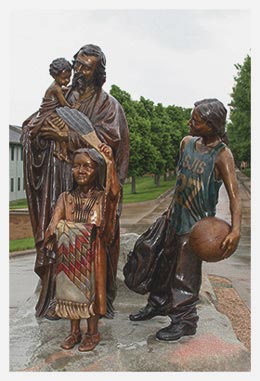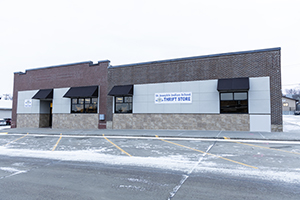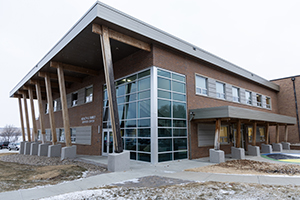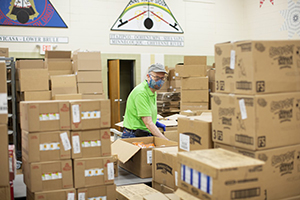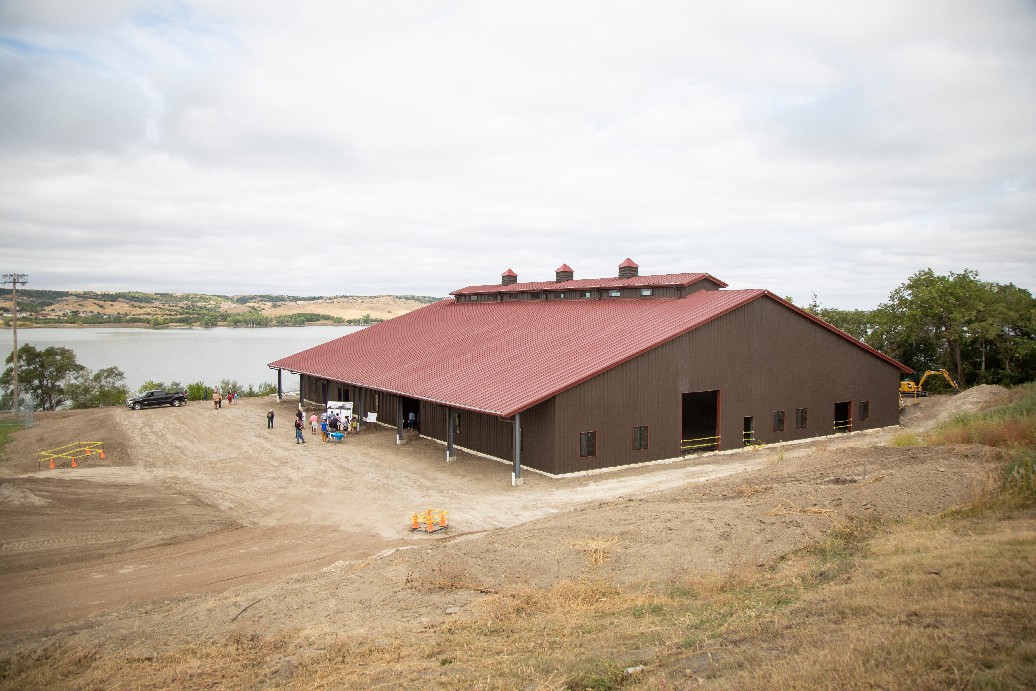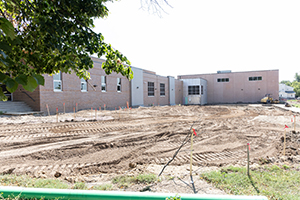Over 98 years serving Lakota children
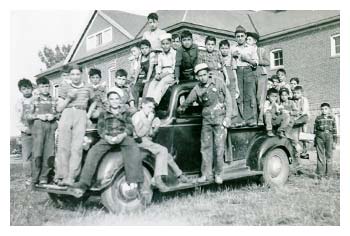
It is difficult to conceive, walking the grounds of St. Joseph's Indian School, how many trials the small educational facility has endured since 1927.
The blue-green stretch of Missouri River here offers no hint of the dust storms and grasshopper plagues of the Great Depression. The tall trees catching the morning sun don't speak of the tornadoes of 1930 and 1931. And, the happy laughter of children playing makes it hard to remember the crackle of fires or bang of hammers rebuilding through the years.
Scroll down and travel back into history and learn the story of St. Joseph's Indian School.
- 1843 – 1925
Fr. Leo John Dehon
Father Leo John Dehon, founder of the Priests of the Sacred Heart, believed in responding to God's love by trying to meet the needs of those around us.

- March 14, 1843: Born in LaChapelle, France
- December 19, 1868: Ordained as a priest, served as First Vatican Council clerk, then appointed to Saint Quentin Parish.
- June 28, 1878: Founded Congregation of the Priests of the Sacred Heart (SCJs)
- August 12, 1925: Died in Brussels, Belgium.
- Visit poshusa.org for more details.
- 1890 – 1941
Fr. Henry Hogebach

In 1923 Fr. Henry Hogebach, SCJ came to the US from Germany. His ministry led him to the Lower Brule Reservation in South Dakota.
In the spring of 1927 Fr. Hogebach received permission to purchase the Columbus College campus at Chamberlain, South Dakota for $40,000.
In the fall of 1927 Fr. Hogebach opened St. Joseph's Indian School with 53 Lakota boys and girls.
In the following years, the school saw many hard times, but through God's grace and Fr. Hogebach's dedication school opened every fall.
Through the gifts from many generous friends, Father Hogebach was able to obtain enough supplies to meet the needs of the children and Benedictine Sisters who worked there.
Much of his time was spent raising funds to keep the school open; donations of clothing, shoes, medication and other supplies were greatly appreciated and well-used … just as they are today.
Over 90 years later, St. Joseph’s Indian School serves 200 Lakota boys and girls, providing them with a safe, stable environment that responds to the needs of the whole child — mind, body, heart and spirit.
- Winter 1928
Fr. Henry went east to solicit sisters for the coming year. He was promised four sisters from Glen Riddle, Pennsylvania for the new school term: two teachers and two sisters for the housework. The salary the sisters demanded was a daily prayer for blessings on their community and for vocations.
- 1929
The Franciscan Sisters
 St. Joseph's Indian School became more home-like under the guidance of the sisters in the early years.
St. Joseph's Indian School became more home-like under the guidance of the sisters in the early years.Many years ago, when Father Henry acquired the buildings for St. Joseph's Indian School, he lost no time further developing our Native American school.
The school bus brought 75 Lakota (Sioux) children from the Cheyenne River Indian Reservation to St. Joseph’s Indian School. The mission became more like a home under the guidance of the sisters, and many of the difficulties experienced the first year never made themselves felt in latter years. The American Indian children became very attached to the sisters.
Contine scrolling to read excerpts from the sisters' diary.
- September 1929
The Franciscan Sisters arrived from Glen Riddle, Pennsylvania a few days before school started. Sister Quitteria had 32 years of experience in the classroom. She was the first Superior of St. Joseph's Indian School. Sister Jeanne (teacher), Sister Columba, Sister Lillian and Sister Ambrosia took over the domestic charges.
1929 – 1938
- Sister's Diary | Nov 28, 1929
Thanksgiving week was a busy one at St. Joseph's. Two government doctors and a nurse paid us a visit to look after the health of the children. Six had their tonsils removed and five had their eyes operated on for Trachoma. All operations proved successful even though the little patients could not see what they were eating and the tonsil patients were not able to swallow.
- Sister's Diary | Jan 3, 1930
Our laundry building was destroyed by fire. The priest's dining room was taken over for the laundry. Today is washday and since it has been rather cold for a long time, all the water lines leading to the building are frozen. The big boys are busy thawing them out with blow torches. It is a real calamity to be without water. Our whole water system ought to be changed, but our empty treasury forbids even such necessary improvements.
- 1931
 This is the original St. Joseph's Indian School. It was destroyed by fire in 1931.
This is the original St. Joseph's Indian School. It was destroyed by fire in 1931. - Sister's Diary | 1934-1935
The depression is at its peak and times are hard. In the spring Sr. Pauline took sick and had to be taken to the Pierre Hospital. She recovered somewhat, but before the new school year opened the Lord called His faithful handmaid home. Sister Cecilia and Helen Durkin were quarantined for several weeks after contracting scarlet fever.
Many of the children were undernourished and sickly. In November we sent one little girl away because her condition was a danger to the other children with whom she associated. She had neither parents nor home. An old Indian lady took her, but she was very poor and had not much herself. We tried everything to get the child into a hospital or sanitarium. We had no success. The girl developed tuberculosis and died three months later.
- Sister's Diary | Dec 25, 1935
At midnight Mass, the crib with baby Jesus greets the children and makes them happy. Brother Mathias spent many an hour building it. The Sisters and the older girls knew how to make it look real. The cave in Bethlehem is there, the shepherds and their flock and in the distance the mountains of the Holy Land. Father explained to the children that the first and best Christmas gift is Our Lord, who became our Brother. From Him all other gifts take their meaning.
- Sister's Diary | Mar 28, 1937
Easter joy reigned everywhere on the mission. The hard days seemed to be over. Our electricity has been connected again and the sun did its best to melt the huge drifts of snow.
- Sister's Diary | May 1937
The results of the examinations are in. Evelyn, one of our Indian children, was highest in the county among 99 eighth-grade graduates. Besides holding the first place in the county, two others made the Honor Roll. The achievement is more outstanding when one considers that the children spend only half a day in class, the other half is taken up with manual training and work in the different departments of the school.
- Sister's Diary | Apr 30, 1938
 St. Joseph's children gather at the Grotto of the Blessed Virgin Mary.
St. Joseph's children gather at the Grotto of the Blessed Virgin Mary.Yearly May devotions start again in front of the Grotto of the Blessed Virgin Mary. During the evening recreation, the bell rings and the children and Sisters gather from wherever they may be at the time to honor the Blessed Virgin. The singing and prayer in the open air appeal to all.
1941 – 1950
- Sister's Diary | Jan 7, 1941
 Fr. Henry was killed in a car accident on January 7, 1941.
Fr. Henry was killed in a car accident on January 7, 1941.Father Henry, the founder of St. Joseph's, is dead — the victim of a reckless driver. Father Henry was on his way from Donaldson, Indiana to Chicago with Brother Fidelis. He was to address a meeting in Chicago about our work in the missions in this country and abroad. Passing an intersection on Highway 6 near Calumet City, a car from a side road, disregarding the stop sign, ran into his car. Father Henry and Brother Fidelis were killed instantly.
- Sister's Diary | Sept 1941
School opens in September with the following Sisters: Sr. M. Raphael, Superior; Srs. Cherubim, Cecilia, Hyacinth, Innocent, Camilla, Daniel, Melitta, Linus, Candeda, Eloba and Ruby. We have 160 children. Military training is felt even on the missions. So far, we have not succeeded in finding a Prefect for our boys. Brother John has come to help Brother Mathias.
- Sister's Diary | Summer 1942
This year the wide prairie is inhabited by thousands of seagulls. At mealtime, they swoop down on the prairie. It seems not a single hopper can escape wherever the ravenous birds are. The gulls must be God’s answer to our repeated prayers for deliverance from the insect pests. Hay is abundant and rich and there is no need to worry about feed for the livestock. The pastures are better than ever. We are able to keep our dairy herd on the mission this year. The war has brought higher prices in everything.
- Sister's Diary | Jan 1943
The registration of our oldest boy has brought the war closer to us than at any other time. Through no fault of his own, Wilfred is older than the average boy in the eighth grade. Nevertheless, it sounds strange that boys in grade school must leave for the army camp. Wilfred is gone now, awaiting the call of this country. He has not finished eighth grade.
- Sister's Diary | Sept 1947
 These girls have just arrived at St. Joseph's Indian School.
These girls have just arrived at St. Joseph's Indian School.1947-1948 marks the 20th anniversary of St. Joseph's. A larger enrollment than ever brought our total number of Indian students to 221. Many of the children this year are quite small. With so many small ones, it means additional work for the Sisters, who must constantly look after the “Little Tribe” for they are far too small to do everything for themselves. The children do not mind the limited space. At home, an entire family is often held to a one-room shack. Here they can go to school, have warm meals, learn religion, and enjoy the companionship of other little girls and boys.
- Sister's Diary | Sept 1949–1950
Two hundred and thirty youngsters came, bringing with them just the clothing they were wearing. We need everything for the children. Yet, who can turn away a homeless orphan or neglected child?
School has begun and already we have a flock of food bills to contend with. Our “Little Tribe” has increased in numbers. So much so, that every place is filled to capacity. We are short desks, more beds are needed, and chapel space is at a premium. The walls bulge, there are a few moans and groans — but, seemingly we live through it.
1952 – 1964
 St. Joseph's children playing on the playground, enjoying the day.
St. Joseph's children playing on the playground, enjoying the day.- Sister's Diary | May 1952
Our graduation class numbers 16 boys and girls who reach a new milestone in their lives. Much depends on the road they choose this summer. In giving prizes at the end of the year, special attention was given to good behavior.
- Sister's Diary | December 1953
After much prayer and pleading, we were finally allowed to have the plans for the new chapel completed, but when the time came to open bids, permission on the part of the Provincial to go ahead was refused. Sadness filled the hearts of all at St. Joseph's. The Christmas campaign was exceptionally good and the money for the building was almost together. (Editor's note: Our Lady of the Sioux Chapel was dedicated in 1956.)
- Sister's Diary | Sept 1955 – 1956
Opening of school and 260 children enrolled. Overcrowded facilities will readily prove that St. Joseph's was never built to house 260 boys and girls. However, where there is a question of need, we strain our effort in every direction. We fail only in regard to the chapel where it is a physical impossibility to fit some of our tiniest tots for daily Mass and Benediction.
- Sister's Diary | Summer 1957
There are a lot of noises here like: the big booming sound of dump trucks and steel trucks carrying in supplies for the construction work; the whirring of grass mowers, continually giving our lawns a short butch haircut; the pounding of the carpenters, hammering nails and sawing boards. The new boys' house is growing by leaps and bounds as Hugh McGranns' men lay bricks and hoist heavy steel beams into place. Already, the brick building has grown up to the second floor and the contractor hopes to have it under roof by the end of October. In the basement floor, there will be shops for the workmen, the carpenters, electricians, the plumbers, painters, and mechanics. Up on the ground floor, the workers are pouring the playroom floors and the athletic room. You can look out the playroom windows and see the mighty muddy Missouri River flowing by. In the athletic room, basketball hoops will be hanging from the walls for practice games.
 The boys from St. Joseph's Indian School are chopping firewood.
The boys from St. Joseph's Indian School are chopping firewood.- Sister's Diary | Dec 25, 1958
All of the children remained with us this year for Christmas. It was, as always, a very happy time. The children attended Midnight Mass the night before and another Mass at 8:00 in the morning. In the afternoon, they had their usual Christmas party.
- Sister's Diary | September 1960
School opens with an enrollment of 331. This year the school has a new Principal, Sr. Canicia. Being Principal of a grade school is an old task for Sister, but this year is her first in charge of a boarding school. She is also teaching the eighth grade. This means much of the desk work in connection with the school will be transferred to our office.
- Sister's Diary | May 1964
This year, graduation exercise had a special touch. For the first time, the class wore beautiful red graduation gowns. Father Jude delivered the graduation address and passed out the diplomas. At the exercise, Sharon and Lawrence were given the awards for being the best all around eighth graders. Evangeline and Leonard were given the awards for having the highest averages.
1968 – 1999
- 1968
The new school (Akta Lakota Museum and Cultural Center today) was built to relieve overcrowding. The nuns were replaced with lay volunteers when the school was built.
- 1970
The present dining hall was completed with modern facilities. Today, it provides lunch during the school day and serves as a grocery shop for the homes.
- 1975
A new gym with a swimming pool was built to provide year-round activities for the students, especially during the long winter months.
- 1979
This was an experimental year. Ten students and two houseparents were housed in the St. Francis Home to give the students a more family-like setting. After evaluation, this living arrangement was found to be beneficial for the students.
- 1980-1983
The conversion from dormitories to residential living units was completed. Each home houses 10-12 students. Family living units changed the way St. Joseph's operated by providing a wholistic approach of care for the students.
- 1985
 The Indian Christ tapestry, by Lakota artist Oscar Howe, is the focal point of Our Lady of the Sioux Chapel.
The Indian Christ tapestry, by Lakota artist Oscar Howe, is the focal point of Our Lady of the Sioux Chapel.Our Lady of the Sioux Chapel, built in 1956, was completely remodeled. The Catholic and Lakota traditions are brought together in the chapel design.
- 1989
The former boys' dormitory, facing the Missouri River, was remodeled into classrooms to allow 12 students per class. Smaller classrooms were needed to better assist the various student needs.
- 1990
The development office and visitor's center opened in 1990. The visitor's center welcome 25,000 visitors to campus each year. The development office reaches out to millions of people each year to join in social service and apostolate of prayer programs.
- 1991
The high school boys' home is purchased. This is the first family living unit located off St. Joseph's campus. One of the reasons for locating the home in town was to integrate the program more closely into the life of the local community.
- 1991
 The Akta Lakota Museum & Cultural Center honors the Lakota people and serves as an educational center for the Lakota children at St. Joseph's Indian School.
The Akta Lakota Museum & Cultural Center honors the Lakota people and serves as an educational center for the Lakota children at St. Joseph's Indian School.The round school was converted to the Akta Lakota Museum & Cultural Center to showcase and embrace Lakota culture.
- 1994
Tipi Press Printing opens providing an on-campus print shop to print direct mail for the development program. Tipi Press Printing brings greater flexibility and decreased costs.
- 1996
The Thiyóšpaye Center opens, allowing families of students a place to stay while visiting their children on campus.
2000 – present
- 2000
A tunnel was built between the Akta Lakota Museum & Cultural Center and gym to connect heating, etc.
- 2001

A new SCJ home was constructed for religious staff.
- 2003
Opened the Kateri Home — two new high school homes — after renovating the former SCJ residence.
- 2003
Purchased Main Street building for the Thrift Store. Some of St. Joseph's students are employed at the Thrift Store. The store supplies clothing to people from around the area, including local reservations.
- 2004
 The Sacred Hoop Center offers a cozy spot for families to stay when visiting their students on campus.
The Sacred Hoop Center offers a cozy spot for families to stay when visiting their students on campus.Built the Sacred Hoop Center to integrate family members into day-to-day student programming at St. Joseph's.
- 2006
30th Annual Powwow and ground breaking for two new high school homes.
- 2007
New high school homes are dedicated during the 31st Annual Powwow. A new bronze statue was unveiled and dedicated at the entrance of St. Joseph’s Indian School.
 “The foundational sculpture is titled “St. Joseph and Child.” He is symbolic of our staff who hold the child as they learn together.”
“The foundational sculpture is titled “St. Joseph and Child.” He is symbolic of our staff who hold the child as they learn together.”
~John Beheler & Darwin Wolf - 2008
St. Joseph’s Indian school updated their Recreational Center with new flooring, lighting, and paint.
- 2009

Murals depicting tribal flags were created and mounted on the walls of St. Joseph’s Dining Hall. Renovation on the Cyr and Perky Homes is completed.
- 2010
Our Lady of the Sioux Chapel received underpinning and re-roofing. Renovation on the Fisher and Pinger Homes is completed.
- 2011
Renovation on the Speyer and Rooney is completed. Renovation begins in the Akta Lakota Museum & Cultural Center.
- 2012
Renovation of the Stevens and Mathias Homes was completed. The Tokéya uŋkí nájiŋpi (We stood here in the beginning) Alumni & Historical Center is completed. The historical center’s mission is to create an experience for visitors that embodies the school’s motto: “We Serve and Teach; We Receive and Learn” and preserve memories and bear witness to the diversity, challenges and accomplishments of the religious community, students, staff and benefactors of St. Joseph’s Indian School since its founding in 1927. The alumni area is designed to help former students connect with classmates, teachers, religious mentors, and staff.
- 2013

St. Joseph's Thrift Store opens at its new location on North Main Street. St. Joseph's Personal Care Center opens on Main Street in Chamberlain. St. Joseph's Donor Care Center opens in Sioux Falls, South Dakota.
- 2014
With other home renovations complete, the David Home reopens to house 12 Lakota girls in grades 1-3 bringing St. Joseph’s home total to 20.
- 2015
St. Joseph's Indian School opens two senior homes on campus. These homes provide opportunities for St. Joseph's high school seniors to learn skills and responsibilities they will need to be successful after graduation.
- 2016
St. Joseph’s Indian School breaks ground on a new health center. The Health and Family Services Center will enable our health center and counseling staff to provide comprehensive, holistic care for our students and their families in an ADA-compliant, private space.
- 2017

Ribbon cutting is held at St. Joseph’s 41st Annual Powwow for the new Health & Family Services Center.
- 2018
Equine Therapy is welcomed as a new therapy practice in working with the children.
- 2019
Construction broke ground on the Sacred Heart Family Safe Shelter, a domestic violence shelter on the Cheyenne River Indian Reservation. The new facility provides safety and care to men, women and children needing a secure place during dangerous situations.
- 2020

The Coronavirus pandemic occurred, but St. Joseph’s Indian School’s services did not falter. Staff delivered food boxes curbside to families, and increased other outreach measures, to makes sure students and families were fed and safe throughout the pandemic.
- 2022
Construction begins on the Equine Therapy Center, a facility on the north end of campus to house Equine Therapy and other programs. The primary function of this center is to help children heal by forming connections with a šúŋkawakȟáŋ — horse.
- 2023

The Equine Therapy Center celebrates its grand opening. The center will allow for year-round equine therapy sessions and allow St. Joseph’s to house up to 10 horses. View a tour of this incredible building by watching this video. Following the theme of growth and modernization, ground was broken on the Rec Center Renovation and Expansion. The new will provide two separate gyms, a separate staff and student workout area, new game room, conference room and offices, upgraded restrooms and showers and several other improvements.
- 2024

Phase 1 of the Rec Center Renovation and Expansion was completed. Rec Center programming was moved into the new addition to make way for renovations to take place in the previous spaces. You can view a full timeline and learn more about this Rec Center project here.

